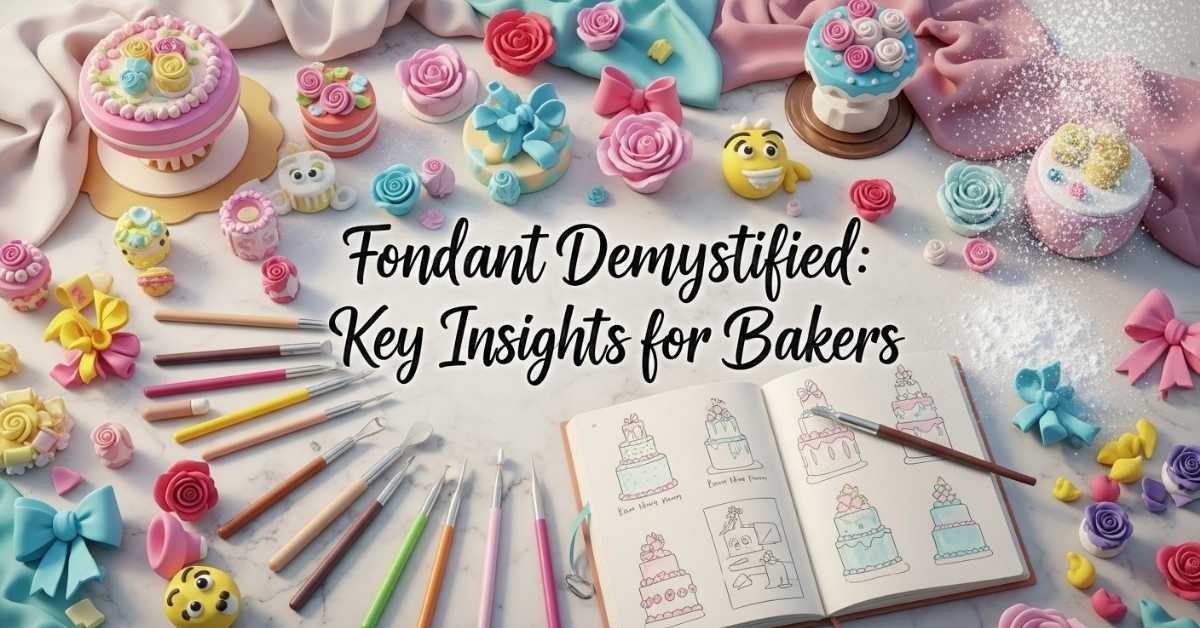Here at Baking Class in Chennai, where we offer Bakery Training In Chennai under the tutelage of experts, we often find that fondant causes enthusiasm and fear among beginners. Fondant with its smooth, elegant finish can make any cake—but most individuals are not sure how to handle it or how to flavor it. Just follow this step-by-step guide and learn the basics, get familiar with the steps, and gain enough confidence to work with fondant like an expert.
1. What Is Fondant?
Fondant is an icing made from sugar that, properly prepared or treated, achieves cakes that perfect, even, matte finish bakers adore. Typically created from sugar, water, gelatin (or agar), vegetable fat or glycerine, fondant exists in many forms, such as rolled fondant and poured fondant.
- Rolled fondant is similar to pliable clay, rolled out like paste to cover cakes and embellished with forms such as flowers or appliqués.
- Poured fondant has a liquid-like smooth consistency, usually employed in coating candy or pastry.
In Baking Class Chennai, our practical Bakery Training focuses on perfecting rolled fondant: rolling, smoothing, trimming, and sculpting.
2. Why Use Fondant?
Fondant provides a number of benefits to cake displays:
- Smooth, professional finish – Suitable for weddings, birthdays, and business events.
- Sculptability – Draw very detailed shapes, 3D characters, and appliqués.
- Color versatility – Easily colored or augmented with edible powders such as lustre dust for shimmering effects.
In our academy, students master how to mix fondant to the correct bendiness, roll it out evenly, and place it without tearing or breaking.
3. Common Issues & How to Resolve Them
Even with experience, working with fondant has challenges. This is how we teach our students to troubleshoot:
- Dry or Cracked Fondant: Due to inadequate storage or over-rolling. We demonstrate how to knead in moisture or repair cracks with gentle smoothing.
- Sticky or Sagging Fondant: Too much moisture or insufficient kneading may result in slippage. Lesson: dust correctly with corn starch when rolling and roll to consistent 2–3 mm thickness.
- Heavy Cakes: The weight of fondant. Our Bakery Training program addresses internal supporting structures—boards, dowels, or even layers of edible rice paper—for tiered cakes.
We also demonstrate how to apply luster dust for a sophisticated shine that will neither affect fondant’s texture nor lead to cracking.
4. Types of Fondant We Teach
- Commercial Ready-Roll Fondant: Simple, pre-colored, readily available.
- Marshmallow Fondant (MMF): Made at home with marshmallows, powdered sugar, water, and shortening—a cost-effective, tasty choice suited for home bakers.
- Fondant Sculpting: A more rigid form used on figures or hard-edged trimmings.
- Sugar Paste/Gum Paste: Hardens entirely, best for flowers, figurines, and decorations that have to hold shape.
In our hands‑on Baking Classes, each type is tasted for texture, flexibility, flavor, and best use situations—so you can decide the best one for your project with confidence.
5. Tips from Our Cake Decoration Class
Here’s what we do at actual practice sessions:
- Lightly dust your working area with powdered sugar or corn starch—never excessive.
- Roll from the middle out evenly in all directions so that the fondant is even.
- Use a fondant smoother tool to remove air bubbles while applying it on your cake.
- Cut off excess evenly around the bottom for a neat, clean appearance.
- Refrigerate rolled fondant wrapped in plastic and cling wrap to keep moist.
Our instructors show you these techniques live, so you get the advantage of expert instruction—and tips from the pros that you won’t get with cookie-cutter online tutorials.
6. Fondant Decoration: Innovative Choices
Following essential covering, we teach how to add decorations:
- Appliqué & cut-out designs: Cut with cutters, stamps, or freehand for floral, leaf, or theme shape motifs.
- Ruffles and drapes: Create luxurious fabric-like textures.
- Paint & lustre finishes: Use edible lustre dust or food-grade paint for fine detailing and gloss.
- Figurines and sculpted toppers: Suitable for birthday cakes, theme parties, or masterpieces with sculpting or gum paste.
These methods allow bakers to turn an otherwise plain fondant-covered cake into a true showstopper.
7. Why Study Fondant at Our Academy
- Methodical curriculum: From initial kneading to complex sculpting (perfect for home bakers and prospective professionals).
- Small batches, personal touch: Every student receives individualized attention.
- Professional expertise: You’re not only taught technique, but real-world workflow, timing, storage, and client-ready finishes.
- Experienced mentors: Our instructors pass on practical advice gained from years of cake baking.
Conclusion
At Baking Class in Chennai, fondant is not just icing—it’s an instrument of artistry. When you pursue our Bakery Training In Chennai, you can expect to unravel every step: choosing the perfect fondant, managing it effortlessly, perfecting all those things that go awry, and using it to decorate with flair. From smooth coverings to sculpted toppings and delicate floral appliqués, you’ll be proficient at crafting cakes that are as stunning as they taste.
If you’re ready to take your baking journey to the next level, join us today. And if you just so happen to be in or near Ambattur, don’t miss our locally optimized sessions — our Baking Classes in Ambattur offer the same world-class training, in a convenient location that pulses with the energy of baking.


